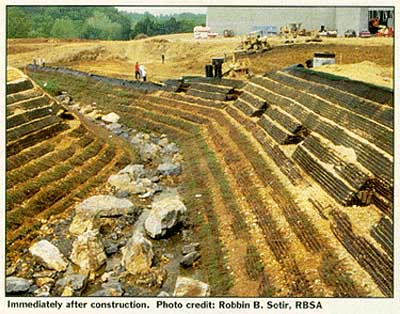Stream Realignment and Restoration Achieved Through Partnershipby Robbin B. Sotir, Robbin B. Sotir & Assoc, and Lisa Frazier, Tensar Earth Technologies, Inc. |
 Project Design and Field Modifications The Norton Branch Tributary to the Pigeon River is a meandering plane-bed type stream carved from alluvial soils. Because it interfered with the proposed main entrance off Highway 441 for a future Wal-Mart Supercenter, 650 feet in channel length was redirected by damming and diverting the stream in three sequences. This project presented many challenges, not the least of which was the first phase: realigning a stream and restoring it with steep embankments to maximize land use due to a constrained footprint. From the project's inception, state agencies required that a natural environment be reestablished with regard to the stream. This stipulation eliminated many conventional alternatives, but led the project civil engineer, South and Associates, Birmingham, AL, to Tensar Earth Technologies, Atlanta, GA, and the consulting soil bioengineers, Robbin B. Sotir & Associates (RBSA), Marietta, GA, along with EGIS Environmental Consulting, Bentonville, AR. Together they created a geosynthetic, soil bioengineered solution. The second and third phases of the project were diversions to construct a detention pond. The detention pond was created to collect run-off from the store site and the parking lot. In a crude form of purification, sediment settles to the bottom of the pond before the water is released into the stream in controlled increments. While creating the pond and reinforcing the stream embankments, construction had to accommodate traffic along Highway 441 South which could not be closed. Another complication was that major utilities such as gas, fiberoptic, cable, and sewer lines were already in place when construction began. The final engineered solution accomodating these site conditions adopted the revised embedment geometry that was required for both the utilities and the road. To maximize the available land for the store and to construct the entrance as planned, a steepened slope was created along the stream. According to the Tennessee Department of Natural Resources and environmentalists' stipulations, the slope could not use a concrete retaining wall or even a gabion structure. Timber would have been a viable solution to satisfy the aesthetic requirements; however, it degrades quickly without a chemical treatment that would have been toxic to aquatic and riparian life (i.e., frogs, turtles, salamanders). Instead, a mechanically stabilized earth (MSE) system was selected: the Sierra¨ Slope Retention System. This solution was the most adaptive for the project needs. It provided the greatest ease in accommodating channelization of the river and flood control, which was required for the soil bioengineering portion of the project. The steepened slope retention system provided unparalleled structural integrity while stabilizing the regraded, steep 1H:1V and 2H:1V slopes along the diverted stream. By using this system, the construction supervisor for the Sierra Slope, Michael Eadie of Wall Technologies Company, Atlanta, GA, was able to avoid limitations imposed by soil conditions and specialized labor requirements, while Wal-Mart escaped the stark appearance of conventional retaining walls. The flexibility of the system enabled Sierra to be used in conjunction with RBSA's soil bioengineering design. This design was used in place of Tensar's erosion control system which is typically integrated into the package. Where the company traditionally employs natural herbaceous vegetation reinforced with erosion and stabilization products, soil bioengineering technology uses woody live plant materials incorporated with geotechnical materials as a long-term component to achieve land stability solutions. Robin B. Sotir & Associates was commissioned to provide soil bioengineering consulting services to determine how biotechnically capable vegetation could be incorporated into the reinforced slope to revegetate the slopes in order to accomplish the following objectives:
EGIS Consulting was in charge of in-stream restoration efforts. This work included recommendations for the placement of large boulders in the stream bed and the creation of snags along the banks to enhance aquatic and wildlife habitat. It was determined initially that willow cuttings and dogwood would be placed between the five lowest lifts of the Sierra Slope Retention System, essentially to the height of the highest anticipated storm event. The remaining upper lifts would not include woody vegetation, but would be hydroseeded. Because of delayed construction and other considerations, commercially available bare root plants were used. On-site supervision of the installation procedures was performed by RBSA.
Construction of this project was completed on May 3, 1995. As part of their contract, RBSA performed two years of evaluation and monitoring and the following are their observations. This article can be found in its entirety in the Mar/Apr '97 issue of Land and Water Magazine. |
©2000, 1999, 1998 Land and Water, Inc.